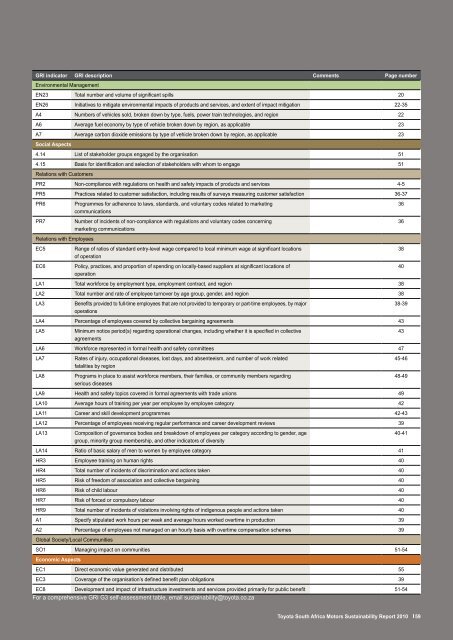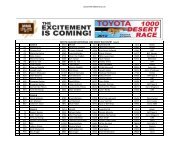to download PDF version - Toyota
to download PDF version - Toyota
to download PDF version - Toyota
Create successful ePaper yourself
Turn your PDF publications into a flip-book with our unique Google optimized e-Paper software.
GRI indica<strong>to</strong>r GRI description Comments Page number<br />
Environmental Management<br />
EN23 Total number and volume of significant spills 20<br />
EN26 Initiatives <strong>to</strong> mitigate environmental impacts of products and services, and extent of impact mitigation 22-35<br />
A4 Numbers of vehicles sold, broken down by type, fuels, power train technologies, and region 22<br />
A6 Average fuel economy by type of vehicle broken down by region, as applicable 23<br />
A7<br />
Social Aspects<br />
Average carbon dioxide emissions by type of vehicle broken down by region, as applicable 23<br />
4.14 List of stakeholder groups engaged by the organisation 51<br />
4.15 Basis for identification and selection of stakeholders with whom <strong>to</strong> engage 51<br />
Relations with Cus<strong>to</strong>mers<br />
PR2 Non-compliance with regulations on health and safety impacts of products and services 4-5<br />
PR5 Practices related <strong>to</strong> cus<strong>to</strong>mer satisfaction, including results of surveys measuring cus<strong>to</strong>mer satisfaction 36-37<br />
PR6 Programmes for adherence <strong>to</strong> laws, standards, and voluntary codes related <strong>to</strong> marketing<br />
communications<br />
36<br />
PR7 Number of incidents of non-compliance with regulations and voluntary codes concerning<br />
marketing communications<br />
36<br />
Relations with Employees<br />
EC5 Range of ratios of standard entry-level wage compared <strong>to</strong> local minimum wage at significant locations<br />
of operation<br />
38<br />
EC6 Policy, practices, and proportion of spending on locally-based suppliers at significant locations of<br />
operation<br />
40<br />
LA1 Total workforce by employment type, employment contract, and region 38<br />
LA2 Total number and rate of employee turnover by age group, gender, and region 38<br />
LA3 Benefits provided <strong>to</strong> full-time employees that are not provided <strong>to</strong> temporary or part-time employees, by major<br />
operations<br />
38-39<br />
LA4 Percentage of employees covered by collective bargaining agreements 43<br />
LA5 Minimum notice period(s) regarding operational changes, including whether it is specified in collective<br />
agreements<br />
43<br />
LA6 Workforce represented in formal health and safety committees 47<br />
LA7 Rates of injury, occupational diseases, lost days, and absenteeism, and number of work related<br />
fatalities by region<br />
45-46<br />
LA8 Programs in place <strong>to</strong> assist workforce members, their families, or community members regarding<br />
serious diseases<br />
48-49<br />
LA9 Health and safety <strong>to</strong>pics covered in formal agreements with trade unions 49<br />
LA10 Average hours of training per year per employee by employee category 42<br />
LA11 Career and skill development programmes 42-43<br />
LA12 Percentage of employees receiving regular performance and career development reviews 39<br />
LA13 Composition of governance bodies and breakdown of employees per category according <strong>to</strong> gender, age<br />
group, minority group membership, and other indica<strong>to</strong>rs of diversity<br />
40-41<br />
LA14 Ratio of basic salary of men <strong>to</strong> women by employee category 41<br />
HR3 Employee training on human rights 40<br />
HR4 Total number of incidents of discrimination and actions taken 40<br />
HR5 Risk of freedom of association and collective bargaining 40<br />
HR6 Risk of child labour 40<br />
HR7 Risk of forced or compulsory labour 40<br />
HR9 Total number of incidents of violations involving rights of indigenous people and actions taken 40<br />
A1 Specify stipulated work hours per week and average hours worked overtime in production 39<br />
A2 Percentage of employees not managed on an hourly basis with overtime compensation schemes 39<br />
Global Society/Local Communities<br />
SO1 Managing impact on communities 51-54<br />
Economic Aspects<br />
EC1 Direct economic value generated and distributed 55<br />
EC3 Coverage of the organisation’s defined benefit plan obligations 39<br />
EC8 Development and impact of infrastructure investments and services provided primarily for public benefit 51-54<br />
For a comprehensive GRI G3 self-assessment table, email sustainability@<strong>to</strong>yota.co.za<br />
<strong>Toyota</strong> South Africa Mo<strong>to</strong>rs Sustainability Report 2010 59





